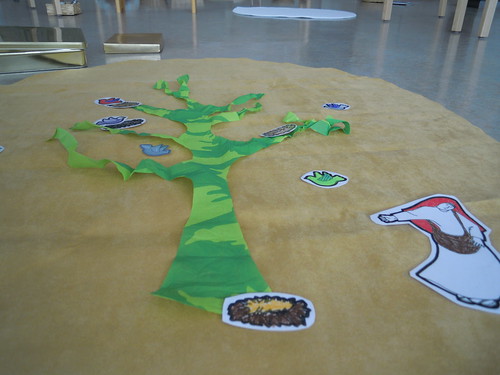Thank you, Leslie, for writing words of encouragement after my last post (about plans for today's Godly Play event), and also to my mother, who sent an email saying she was praying for us. My prayer had been that everyone would get something they needed from it.
There were thirteen of us in the circle. We had children aged 3-5, a young teen, a grad student, parents, adults without children, married couples, and at least one pensioner. We were people born in North America, the Middle East, Eastern Asia, Africa, and Europe (including Finland!).
I told the story of "the Great Family" (of Abraham and Sarah), using a desert bag for the first time in our classroom. This prompted at least two people to make plasticine deserts in the Response Time.
Some people responded to the literal distances in the story and the idea of emigration, while others responded more metaphorically, for example to the idea of travelling through the desert without the refreshment and guidance of a river. One person even connected ideas from this story with insights from a recent television documentary about the Second Law of Thermodynamics!
In the picture below, you can see that Abraham's body has been buried under the "sand".
Afterwards, I asked the children what their favorite part of the day had been. One said working with glue. Another said helping with the feast. However, the feast was something of a disappointment to at least one child, because there was no food, only drink (a decision I'd made because lunch was to follow almost immediately). Also, the children found some of the grown-up talk difficult to sit through: notice the two children amusing themselves below by wearing their napkins on their heads:
We ended our session with a very different kind of prayer time than we've had before. I put the desert out again, and handed around a basket of stones and blocks. Everyone took a turn and put one into the sand. If they wanted to, they said a prayer after doing so, either in their heart silently or out loud.
I think this was the most successful prayer time we've ever had in Junior Church / Godly Play: we have one child who is often very awkward about prayer, but who seemed to handle this activity just fine.
When we got home, Vandriver asked me what my favorite part had been. I said, "Entering the room after preparing the drinks for our feast [during the Response Time] and seeing everyone doing their work - whether chatting together over plasticine, making a glitter glue painting, taking a nap, or reading about prayer."












